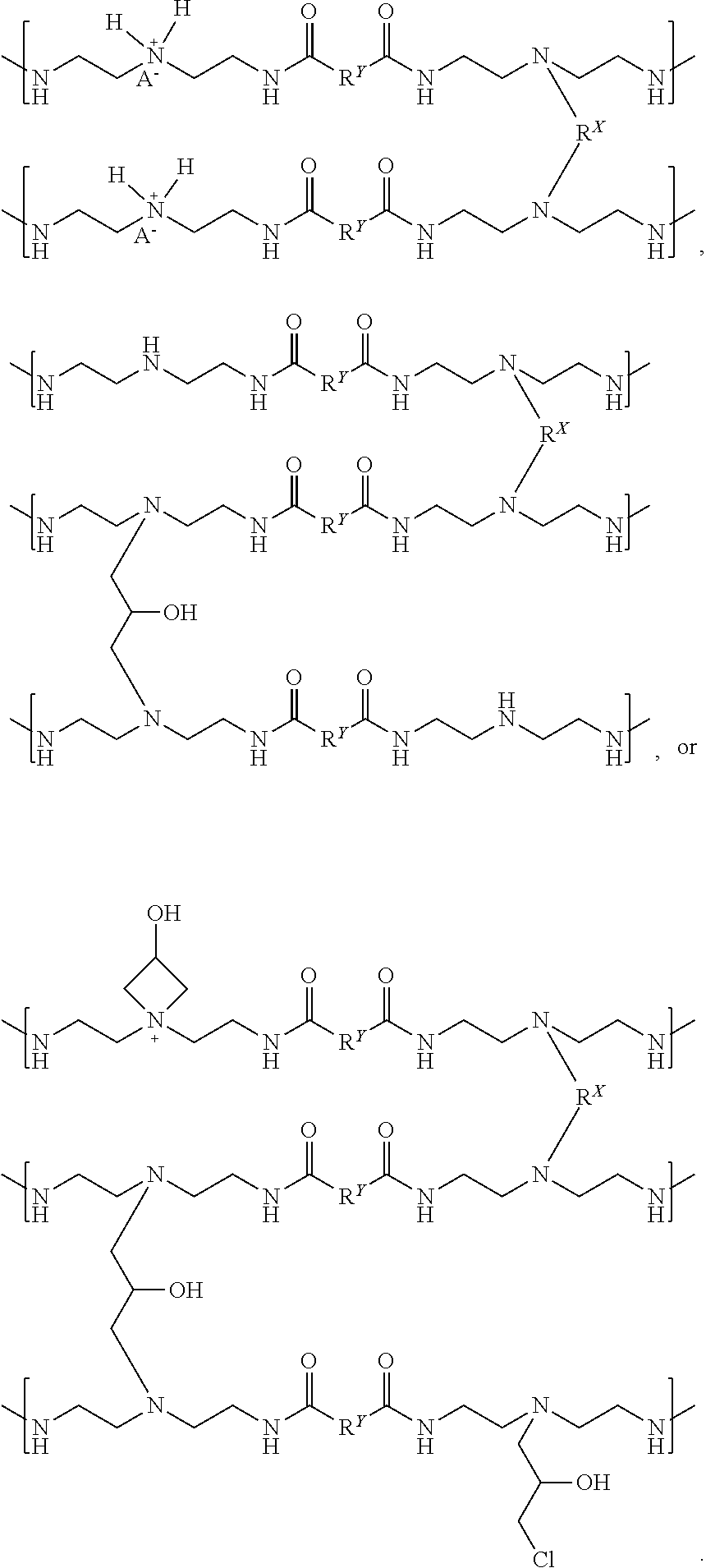Creping adhesives containing functionalized crosslinked resins
a crosslinked resin and creping technology, applied in the direction of adhesives, etc., can solve the problems of poor adhesion, affecting the efficiency of web drying, and affecting the high processing speed needed in current papermaking operations, and achieve the effect of low water solubility
- Summary
- Abstract
- Description
- Claims
- Application Information
AI Technical Summary
Problems solved by technology
Method used
Image
Examples
example 1
r
[0153]A glass reactor with a 5-neck top was equipped with a stainless steel stirring shaft, a reflux condenser, temperature probe, and a hot oil bath for heating. To the reactor was added about 500.5 g of diethylenetriamine (DETA). The agitator was turned on and about 730 g of adipic acid was added slowly over about 45 min with stirring. The reaction temperature increased from about 25° C. to about 145° C. during adipic acid addition. After the adipic acid was added, the reactor was immersed in a hot oil bath heated to about 170° C. At about 150° C. the reaction mixture began to reflux. The reflux condenser was reconfigured for distillation and distillate was collected in a separate receiver. During the reaction period and until the desired viscosity end-point, the temperature of the reaction mixture was gradually heated to about 165° C. The reaction was sampled at intervals of about 30 min to monitor the advancement of viscosity. Each neat resin sample was diluted to about 45 wt %...
example 2
r
[0154]A glass reactor with a 5-neck top was equipped with a stainless steel stirring shaft, a reflux condenser, temperature probe, and a hot oil bath for heating. To the reactor was added about 1,574.5 g of dibasic ester-5 (also known as DBE-5) that contained dimethyl glutarate. The agitator was turned on and about 1,038.9 g of DETA was added with stirring. The reactor was immersed in a hot oil bath heated to about 100° C. At about 90° C. the reaction mixture began to reflux. The reflux condenser was reconfigured for distillation and distillate was collected in a separate receiver. During the reaction period and until the desired viscosity end-point, the temperature of the reaction mixture was gradually heated to about 135° C. The reaction was sampled at intervals of about 30 min to monitor the advancement of viscosity. Each neat resin sample was diluted to about 50 wt % solids with water, cooled to about 25° C., and the viscosity was measured with a Brookfield viscometer. Once the...
example 3
r
[0155]A glass reactor with a 5-neck top was equipped with a stainless steel stirring shaft, a reflux condenser, temperature probe, and a hot oil bath for heating. To the reactor was added about 1,574.5 g of DBE-5. The agitator was turned on and about 1,038.9 g of DETA was added with stirring. The reactor was immersed in a hot oil bath heated to about 100° C. At about 90° C. the reaction mixture began to reflux. The reflux condenser was reconfigured for distillation and distillate was collected in a separate receiver. During the reaction period and until the desired viscosity end-point, the temperature of the reaction mixture was gradually heated to about 135° C. The reaction was sampled at intervals of about 30 min to monitor the advancement of viscosity. Each neat resin sample was diluted to 45 wt % solids with water, cooled to about 25° C., and the viscosity was measured with a Brookfield viscometer. Once the reaction mixture had a viscosity of about 290 cP, the distillation cond...
PUM
| Property | Measurement | Unit |
|---|---|---|
| temperature | aaaaa | aaaaa |
| viscosity | aaaaa | aaaaa |
| temperature | aaaaa | aaaaa |
Abstract
Description
Claims
Application Information
 Login to View More
Login to View More - R&D
- Intellectual Property
- Life Sciences
- Materials
- Tech Scout
- Unparalleled Data Quality
- Higher Quality Content
- 60% Fewer Hallucinations
Browse by: Latest US Patents, China's latest patents, Technical Efficacy Thesaurus, Application Domain, Technology Topic, Popular Technical Reports.
© 2025 PatSnap. All rights reserved.Legal|Privacy policy|Modern Slavery Act Transparency Statement|Sitemap|About US| Contact US: help@patsnap.com



